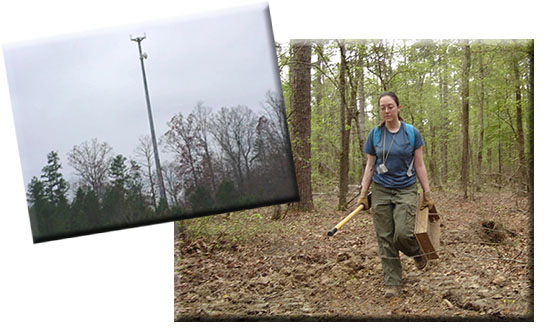
In October 2004, the Federal Communications Commission (FCC) adopted the Nationwide Programmatic Agreement for Review of Effects on Historic Properties for Certain Undertakings Approved by the Federal Communications Commission (NPA). Because cellular tower construction is regulated by the FCC, it is subject to review under Section 106 of the National Historic Preservation Act. The NPA was designed to standardize and streamline the Section 106 review process by coordinating review by State Historic Preservation Officers, Tribal Historic Preservation Officers, and the FCC.
Weaver & Associates has extensive experience in conducting Phase I cellular tower assessments. Generally, these assessments consist of eight parts: (1) a literature and records search; (2) tribal notification through the Tower Construction Notification System (TCNS); (3) public consultation; (4) direct impact (archaeological) assessment; (5) indirect impact (historical architectural/viewshed) assessment; (6) laboratory analysis; (7) report preparation/preparation of FCC Form 620; and (8) tribal consultation.
The literature and records search identifies known historical and archaeological properties within or in the vicinity of the proposed tower site, and establishes a cultural context for understanding any possible cultural resources that might be affected by the project.
Tribal notification is carried out through the FCC Tower Construction Notification System. Information regarding the specific tower, such as location, height, and tower type, is sent via the internet to the TCNS. Notices are then sent by TCNS to Federally recognized Native American tribal entities who have indicated a tribal affiliation and consulting interest in the impacted area. These groups then have the option of choosing to be consulting parties to the proposed construction.
Public consultation includes both coordination with the public agencies and notification of the the public regarding the proposed construction. Normally, public notice involves placement of a notice in a public circulation newspaper.
Direct impact assessment usually consists of a visual, on-the-ground examination of the tower pad and access road. This usually involves excavation of shovel tests within the proposed tower pad and along any access easement.
If artifacts or other materials are collected during the direct impact assessment, they are usually transported to Weaver & Associates' laboratory in Memphis, where they are washed, labeled, analyzed, and prepared for curation according to State and Federal guidelines.
Indirect impact assessment involves identifying historical properties within the Visual Area of Potential Effect and assessing the potential impact of the proposed tower on the visual integrity of such towers.
When an archaeological site or historical property is encountered, sufficient information is presented to evaluate its potential eligibility for listing on the National Register of Historic Places, pursuant to criteria set forth in 36 CFR 60.4.
Once the data has been compiled, a professional report is prepared. Subject to individual state requirements, this may involve an archaeological and historical architectural reports, a FCC Form 620, or both. These reports are then submitted to the State Historic Preservation Officer and Tribal Historic Preservation Officers.
Weaver and Associates has conducted more than 100 cellular tower assessments within the past five years. In addition, we have also worked with clients in preparing and reviewing FCC Form 620 submission packets. We are able to offer both services at a minimal cost and turnaround time.







